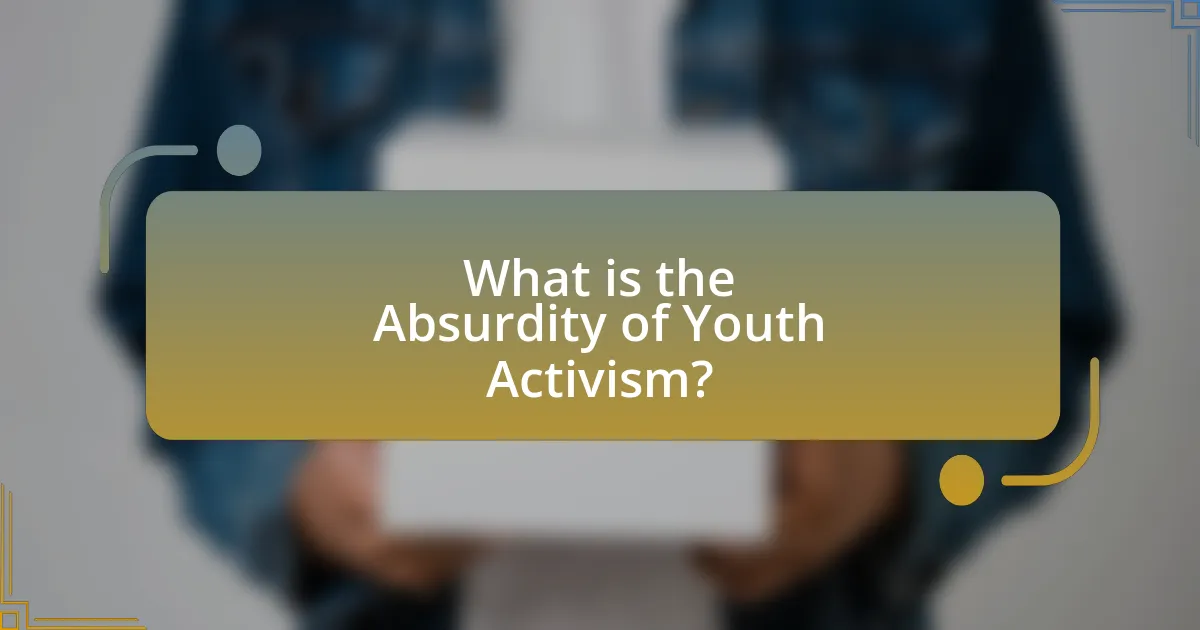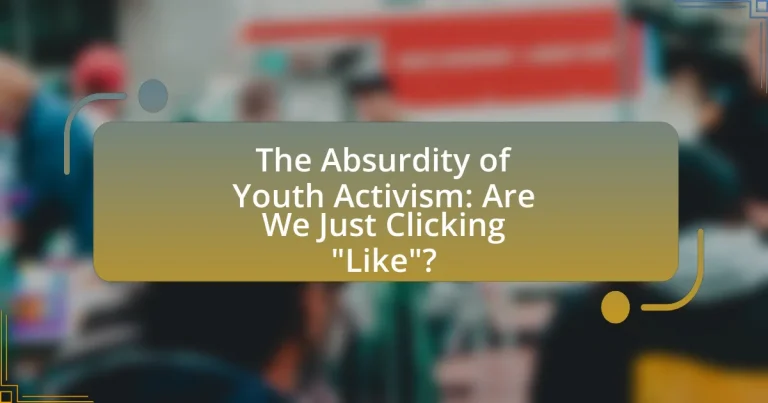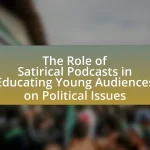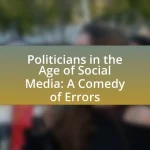The article examines the phenomenon of youth activism, highlighting the perceived absurdity of their engagement, often characterized by minimal tangible change despite passionate involvement. It discusses the generational gap in understanding activism methods, the influence of social media on perceptions and actions, and the criticisms surrounding superficial engagement, known as “slacktivism.” The article also explores the cultural factors contributing to this perception, the implications of passive support for social movements, and strategies youth activists can employ to foster genuine engagement and make a real impact. Through this analysis, the article aims to provide a comprehensive understanding of the complexities and challenges faced by young activists today.

What is the Absurdity of Youth Activism?
The absurdity of youth activism lies in the paradox of passionate engagement often resulting in minimal tangible change. While young activists frequently mobilize through social media and public demonstrations, studies indicate that such actions may not translate into effective policy changes or long-term impact. For instance, a 2020 report by the Pew Research Center found that while 70% of young people express concern about social issues, only a fraction actively participate in sustained advocacy efforts. This disconnect highlights the irony of digital activism, where the act of clicking “like” can create an illusion of involvement without fostering real-world solutions.
Why do we perceive youth activism as absurd?
We perceive youth activism as absurd primarily due to the generational gap in understanding and valuing the perspectives and methods employed by young activists. Older generations often view the digital and social media-driven approaches of youth as superficial or lacking depth, leading to a dismissal of their efforts. For instance, studies show that traditional forms of activism, such as protests and community organizing, are often favored by older individuals, while younger activists utilize platforms like social media to mobilize support and raise awareness, which can be perceived as less serious. This disconnect in communication and values contributes to the perception of absurdity surrounding youth activism.
What cultural factors contribute to this perception?
Cultural factors that contribute to the perception of youth activism as superficial include the prevalence of digital communication and social media, which often prioritize quick engagement over meaningful action. This environment fosters a culture of performative activism, where individuals may feel compelled to express support through likes and shares rather than participating in substantive efforts. Research indicates that social media platforms can create an illusion of involvement, leading to a phenomenon known as “slacktivism,” where users believe that minimal online engagement equates to real-world impact. Additionally, generational attitudes towards activism, shaped by historical contexts and societal norms, can influence how youth perceive their role in social movements, often viewing online actions as sufficient rather than as a starting point for deeper engagement.
How does social media influence our view of youth activism?
Social media significantly shapes our perception of youth activism by amplifying voices and mobilizing support for causes. Platforms like Twitter and Instagram allow young activists to share their messages widely, reaching global audiences and fostering community engagement. For instance, the #FridaysForFuture movement, initiated by Greta Thunberg, gained international traction through social media, demonstrating how online platforms can transform local actions into global movements. This visibility can lead to increased awareness and participation in activism, but it also raises questions about the depth of engagement, as some critics argue that online support may be superficial, often limited to likes and shares rather than meaningful action.
What are the common criticisms of youth activism?
Common criticisms of youth activism include claims of superficial engagement, lack of experience, and being overly influenced by social media. Critics argue that many young activists prioritize online actions, such as liking or sharing posts, over meaningful offline engagement, which can dilute the impact of their efforts. Additionally, some assert that youth may lack the necessary life experience to fully understand complex social issues, leading to oversimplified solutions. Furthermore, the reliance on social media platforms can result in echo chambers, where young activists are exposed primarily to like-minded views, potentially stifling critical discourse and diverse perspectives.
How do critics argue that youth activism lacks depth?
Critics argue that youth activism lacks depth by claiming it often relies on superficial engagement rather than substantive understanding of issues. They point out that many young activists primarily utilize social media to express their views, which can lead to a focus on trending topics rather than comprehensive analysis. For instance, a study by the Pew Research Center found that while 70% of teens engage in social media activism, only a fraction participate in offline actions or informed discussions about the causes they support. This reliance on digital platforms can result in a lack of critical thinking and long-term commitment to the issues, as highlighted by scholars who emphasize the importance of deeper educational engagement in activism.
What role does performative activism play in these criticisms?
Performative activism plays a critical role in the criticisms of youth activism by highlighting the superficial engagement of individuals who prioritize social media visibility over meaningful action. This form of activism often manifests as online gestures, such as liking or sharing posts, which can create an illusion of support without contributing to tangible change. Research indicates that such performative acts can dilute the impact of genuine activism, as they may lead to a false sense of accomplishment among participants, ultimately undermining the urgency of social issues. For instance, a study published in the journal “Social Media + Society” found that individuals who engage in performative activism are less likely to participate in offline activism, reinforcing the critique that many young activists are more focused on their online presence than on effecting real-world change.

Are Youth Activists Just Clicking “Like”?
Youth activists are not merely clicking “like”; they are often engaging in a range of actions that extend beyond social media interactions. Research indicates that many young people participate in offline activities such as protests, community organizing, and advocacy efforts, demonstrating a commitment to social change. For instance, a study by the Pew Research Center found that 57% of young adults have participated in a protest or rally, indicating active involvement rather than passive online engagement. This evidence supports the notion that youth activism encompasses a broader spectrum of engagement than just digital interactions.
What does it mean to “click like” in the context of activism?
“Clicking like” in the context of activism refers to the act of expressing support for a cause or movement through social media platforms by clicking a “like” button. This action often symbolizes a superficial engagement with social issues, where individuals may feel they are contributing to activism without taking further action, such as participating in protests or volunteering. Research indicates that while online engagement can raise awareness, it may not translate into meaningful offline activism, leading to discussions about the effectiveness of digital activism in creating real-world change.
How does online engagement differ from real-world activism?
Online engagement differs from real-world activism primarily in its level of personal involvement and impact. Online engagement often involves actions such as liking, sharing, or commenting on social media posts, which can create a sense of participation without requiring significant commitment or effort. In contrast, real-world activism typically entails direct actions such as organizing events, participating in protests, or engaging in community service, which require more substantial time, resources, and personal investment. Research indicates that while online activism can raise awareness and mobilize support quickly, it may lack the sustained impact and community-building aspects that characterize traditional activism, as evidenced by studies showing that in-person participation leads to stronger social ties and more effective advocacy outcomes.
What are the implications of passive support for social movements?
Passive support for social movements can dilute the effectiveness of activism by creating a false sense of engagement. When individuals express support through minimal actions, such as liking posts on social media, it may lead to complacency and a lack of deeper involvement. Research indicates that while passive support can raise awareness, it often fails to translate into tangible actions that drive change, as evidenced by studies showing that active participation is more likely to result in successful outcomes for movements. For instance, a study published in the Journal of Social Issues highlights that movements relying on active engagement, such as protests or community organizing, achieve greater policy changes compared to those that primarily receive passive support.
How does social media shape the actions of youth activists?
Social media significantly shapes the actions of youth activists by providing a platform for rapid communication, mobilization, and awareness-raising. Through platforms like Twitter, Instagram, and TikTok, young activists can share their messages widely, organize events, and engage with a global audience, which amplifies their impact. For instance, the #FridaysForFuture movement, initiated by Greta Thunberg, gained international attention and participation through social media, demonstrating how digital platforms can facilitate large-scale youth activism. Additionally, studies show that 70% of young people believe social media is an effective tool for social change, highlighting its role in influencing their activism strategies and engagement levels.
What platforms are most influential in youth activism?
Social media platforms are the most influential in youth activism. Platforms such as Instagram, Twitter, and TikTok enable young activists to share their messages widely and mobilize support quickly. For instance, Instagram’s visual nature allows for impactful storytelling, while Twitter facilitates real-time discussions and trending hashtags that can amplify movements. TikTok’s short-form video format has also become a powerful tool for engaging younger audiences, as seen in campaigns like #BlackLivesMatter and climate activism. These platforms have been shown to significantly increase awareness and participation in social issues among youth, as evidenced by studies indicating that social media engagement correlates with higher levels of activism and community involvement.
How do algorithms affect the visibility of youth activism efforts?
Algorithms significantly influence the visibility of youth activism efforts by determining which content is prioritized in social media feeds and search results. These algorithms often favor engagement metrics, such as likes, shares, and comments, which can lead to a skewed representation of activism that emphasizes popular or sensational content over more substantive issues. For instance, a study by the Pew Research Center found that algorithms on platforms like Facebook and Instagram can amplify posts that generate high engagement, potentially sidelining important but less sensational activism efforts. This creates a challenge for youth activists, as their messages may struggle to reach wider audiences unless they conform to the algorithmic preferences that prioritize virality over depth.
What are the Consequences of Youth Activism’s Absurdity?
The consequences of youth activism’s absurdity include a dilution of genuine engagement and a potential backlash against social movements. When activism is perceived as absurd, often characterized by superficial actions like social media likes rather than meaningful participation, it can lead to skepticism among older generations and diminish the credibility of youth-led initiatives. Research indicates that only 3% of young people actively engage in offline activism, suggesting that online engagement may not translate into real-world impact. This disconnect can result in a lack of support for important causes, as stakeholders may question the commitment and seriousness of youth activists.
How does the perception of absurdity impact youth engagement?
The perception of absurdity significantly diminishes youth engagement in activism. When young individuals view social issues as absurd or hopeless, they are less likely to participate actively, often resorting to passive actions like liking posts on social media instead of engaging in meaningful activism. Research indicates that feelings of absurdity can lead to apathy, as seen in studies where youth express disillusionment with traditional activism methods, perceiving them as ineffective. This disengagement is further supported by surveys showing that a majority of young people feel overwhelmed by the scale of social issues, leading to a sense of futility in their efforts.
What are the potential discouragements for young activists?
Young activists face several potential discouragements, including burnout, lack of support, and feelings of helplessness. Burnout occurs when the emotional and physical demands of activism exceed the individual’s capacity to cope, leading to disengagement. A lack of support from peers, family, or community can further isolate young activists, making their efforts feel futile. Additionally, the overwhelming nature of global issues can create a sense of helplessness, where young activists may feel that their contributions are insignificant in the face of systemic challenges. These factors can significantly hinder their motivation and effectiveness in driving change.
How can this perception lead to apathy among peers?
This perception can lead to apathy among peers by fostering a belief that online engagement, such as liking posts, is sufficient for activism. When individuals perceive that their minimal online actions are equivalent to meaningful contributions, they may become disengaged from more impactful, real-world efforts. Research indicates that this phenomenon, often referred to as “slacktivism,” results in a decline in motivation to participate in traditional forms of activism, as individuals feel their online presence suffices. Consequently, the expectation of low-effort involvement diminishes the urgency to take substantive action, leading to widespread apathy within peer groups.
What strategies can youth activists employ to counteract absurdity?
Youth activists can employ strategies such as grassroots organizing, digital storytelling, and coalition-building to counteract absurdity. Grassroots organizing allows activists to mobilize local communities, fostering direct engagement and collective action that challenges absurd situations. Digital storytelling enables youth to share personal narratives and experiences, making complex issues relatable and highlighting the absurdity of inaction. Coalition-building with diverse groups amplifies voices and creates a united front, enhancing the impact of their message. These strategies have been effective in various movements, such as the climate strikes led by youth activists, which have drawn global attention and participation, demonstrating the power of collective action against absurdity.
How can they foster genuine engagement beyond “likes”?
To foster genuine engagement beyond “likes,” organizations can implement interactive initiatives such as community discussions, workshops, and collaborative projects. These activities encourage deeper connections and active participation, allowing individuals to express their views and contribute meaningfully. Research indicates that face-to-face interactions significantly enhance engagement levels; for instance, a study by the Pew Research Center found that 70% of participants felt more connected to causes when involved in direct community activities. By prioritizing these interactive experiences, organizations can cultivate a more committed and engaged audience.
What role does education play in enhancing activism effectiveness?
Education significantly enhances activism effectiveness by equipping individuals with critical thinking skills, knowledge of social issues, and strategies for effective advocacy. Educated activists are more likely to understand complex societal problems, enabling them to articulate their positions clearly and persuasively. For instance, studies show that individuals with higher education levels are more engaged in civic activities and demonstrate greater political participation, as evidenced by the National Civic Engagement Survey, which found that college graduates are 20% more likely to vote than those without a degree. This knowledge empowers activists to mobilize support, influence policy, and create meaningful change in their communities.
What practical steps can young activists take to make a real impact?
Young activists can make a real impact by engaging in grassroots organizing, which involves mobilizing community members to address local issues. This approach has been proven effective, as seen in the success of movements like Black Lives Matter, which began with local activism and grew into a global movement. Additionally, young activists should utilize social media strategically to raise awareness and foster community engagement, as studies show that online campaigns can significantly amplify messages and drive real-world action. Participating in local government meetings and advocating for policy changes can also lead to tangible outcomes, as evidenced by youth-led initiatives that have successfully influenced legislation on climate change and education reform.


